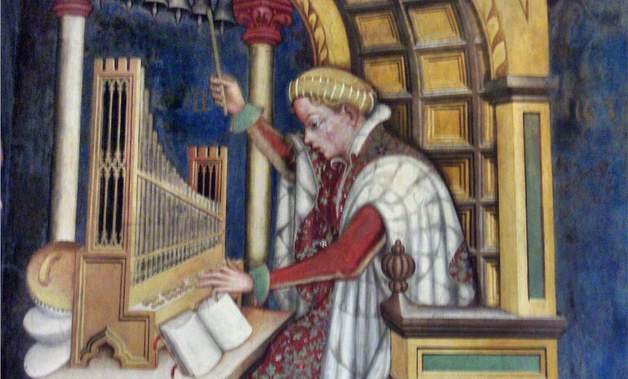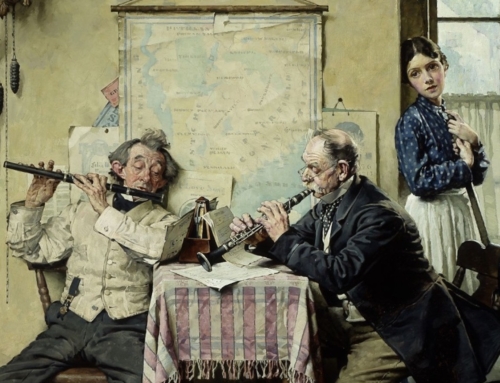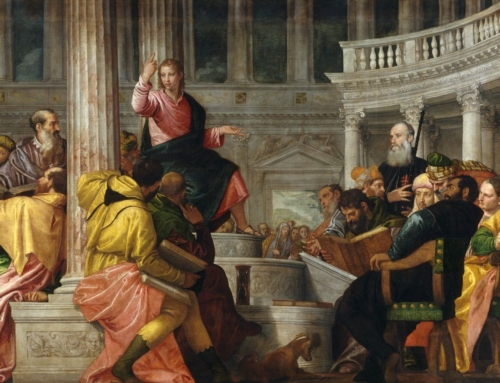In the most recent issue of the Dominicana print journal, I wrote an article about how the Second Vatican Council called for a ressourcement—a return to the sources—regarding the Church’s liturgical music. At the same time, the Council also called for aggiornamento—a bringing up to date or renewal. Our new album, In Medio Ecclesiae—which makes a great Christmas gift for family and friends alike—is our contribution to the fulfillment of both principles, in the authentic spirit of Vatican II.
The Council begins its treatment of music with ressourcement:
The musical tradition of the universal Church is a treasure of inestimable value, greater even than that of any other art. The main reason for this pre-eminence is that, as sacred song united to the words, it forms a necessary or integral part of the solemn liturgy . . . The treasure of sacred music is to be preserved and fostered with great care. (Sacrosanctum Concilium 112, 114)
Most of the music for the album is drawn from this “treasure of inestimable value,” and we hope that our contemporary recording allows it to be “preserved and fostered with great care.” Two of the tracks are chant (tracks 5 and 12) and several of the other tracks are Renaissance polyphony (tracks 1, 2, 4, 7, 9, 10, 11, and 14): these genres are the two which the Council names in particular as part of this treasure of sacred music. All of the music on the recording has been sung for liturgical worship at the Dominican House of Studies.
The Council then finishes its treatment of music with aggiornamento:
Composers, filled with the Christian spirit, should feel that their vocation is to cultivate sacred music and increase its store of treasures. Let them produce compositions which have the qualities proper to genuine sacred music, not confining themselves to works which can be sung only by large choirs, but providing also for the needs of small choirs and for the active participation of the entire assembly of the faithful. The texts intended to be sung must always be in conformity with Catholic doctrine; indeed they should be drawn chiefly from holy scripture and from liturgical sources. (Sacrosanctum Concilium 121)
Two of our tracks in particular aim to fulfill this goal. Tracks 3 and 8 are recent compositions for our liturgies at the Dominican House of Studies and are intended to “cultivate sacred music and increase its store of treasures.” The texts for both compositions are drawn “from holy scripture and from liturgical sources.” While most Americans will hear a song or hymn at the Entrance, Offertory, and Communion during the Mass, each of those parts actually has an assigned chant in the official chant books that is a setting of an assigned text. It is these proper texts of the Mass that form the basis of our two new compositions. The compositions themselves were written not for large choirs but rather for our own relatively small Schola Cantorum of men’s voices and are to be sung a cappella, that is, without accompaniment by the organ or any other instrument.
Track 3, “Thine Are the Heavens,” is a simple and short setting of the proper Offertory text for the Mass of Christmas Day: “Thine are the heavens, and thine is the earth: the world and the fulness thereof thou hast founded. Justice and judgment are the preparation of thy throne” (Ps 89:12, 15a). I wrote the setting for Christmas in 2011 in response to the desire to have a more contemporary English-language setting of the Offertory, in accord with Sacrosanctum Concilium 36: “Since the use of the mother tongue . . . frequently may be of great advantage to the people, the limits of its employment may be extended. This will apply . . . to some of the prayers and chants.” The setting is in four parts with a homophonic texture (each part sings the same words at the same time) that uses contemporary, sweet-sounding harmonies and text painting.
Track 8, Ubi caritas, is a harmonic setting of the proper Offertory chant for Holy Thursday. This chant was originally used for the washing of the feet, the text being a meditation on how love of neighbor makes manifest the love and presence of God. Following the custom of omitting the use of the organ between the Glorias of Holy Thursday and the Easter Vigil, the piece is an a cappella harmonization of the unison chant from the official chant books. The composer, Fr. James Moore, O.P. (the director of our Schola), harmonized first the refrain for Holy Thursday in 2011, and set the verses as well in 2012. In this piece, also, the harmonies are contemporary, but the original chant melody, which is clearly present throughout the piece, is the most prominent part, as can be heard on the album.
By sharing with you sacred music both old and new, in accord with the mind of the Second Vatican Council, our hope is to present an offering that is truly in medio Ecclesiae, in the midst of the Church, and truly beautiful, so as to draw all who hear it closer to God. As we begin to prepare for the celebration of the Incarnation of our Lord Jesus Christ at Christmas, we pray that the music of In Medio Ecclesiae will inspire those who hear it to give their lives, whether for the first time or in a renewed way, to Him.
✠
Image: Gentile da Fabriano, Music, Playing the Organ







